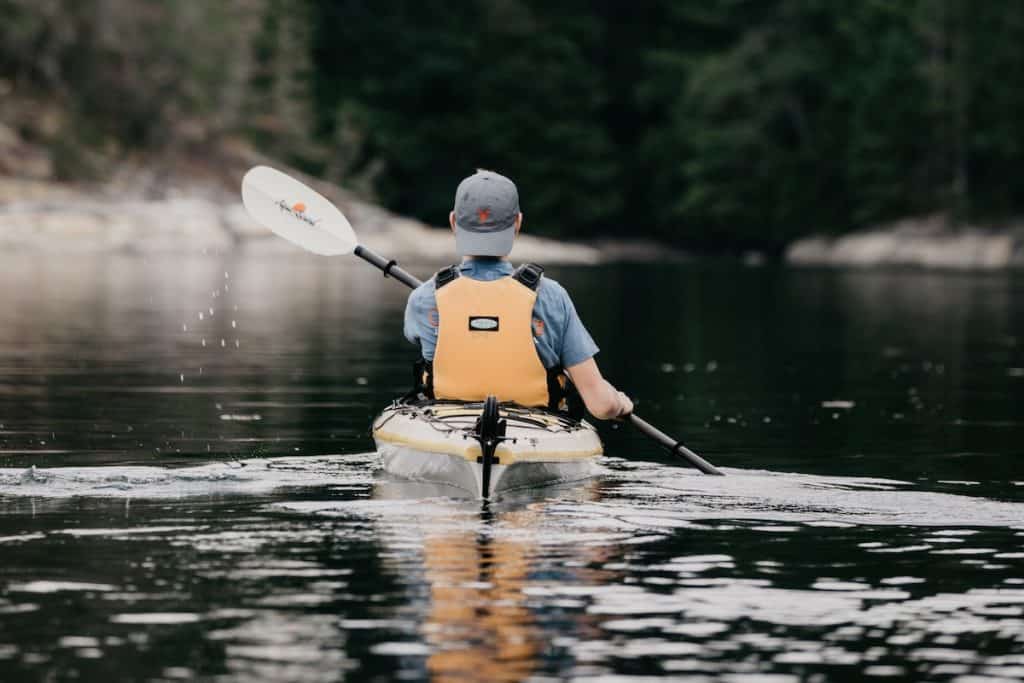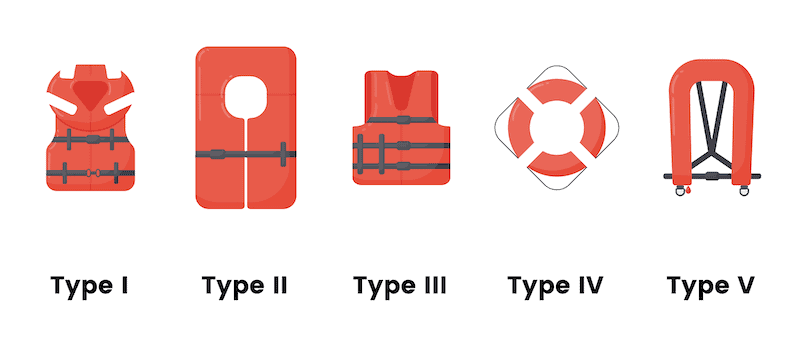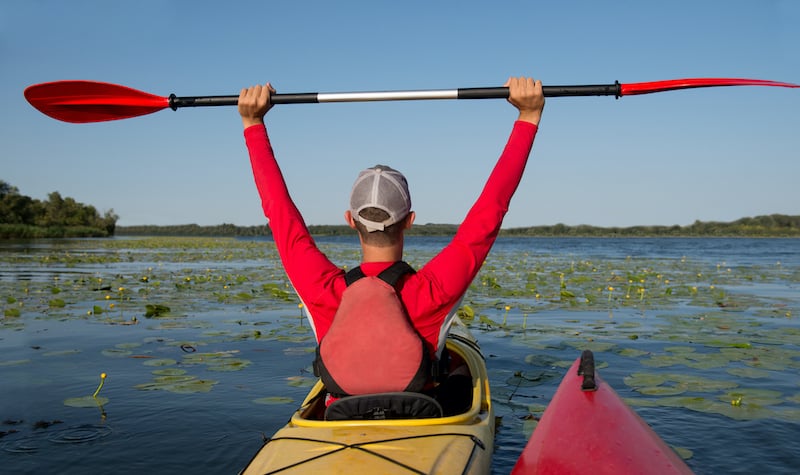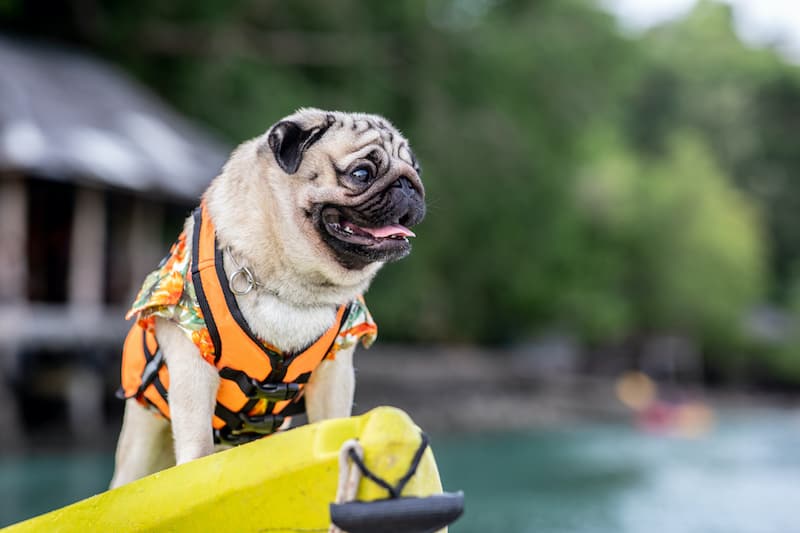If you’re heading out kayaking, then a life vest is an essential piece of safety equipment that you have on board. Even for strong swimmers, they provide extra buoyancy to reduce fatigue and keep you safe out on the water. PFDs are required by both state and federal law. While there are many styles and options, remember, the best PFD for kayaking is the one you use and wear.
In this post, we’re going to be covering the different types of PFDs and what the differences are between them all. But first, what exactly is a pfd?
What is a PFD?

PFD is short for Personal Floatation Device, which is just the Coast Guard’s term for a life vest or life jacket. The Coast Guard certifies life jackets in the United States, and all vessels, including paddle craft like kayaks, must have an appropriate PFD for every person whether they’re a non swimmer or not. Which type of PFD you carry depends on your vessel, what sort of activity you’re engaging in, and where you are boating.
Finding the right PFD always involves a compromise. You can get one with lots of floatation, but it will be large, bulky, and uncomfortable. Or you can find a more comfortable one, but it won’t have nearly as much buoyancy.
Materials Used
Standard life vests are filled with buoyant foam. To get them buoyant enough to keep an adult afloat, some can get rather big and bulky. These PFD designs are the least expensive, plus they come in a wide variety of sizes and styles.
An alternative type is an inflatable vest. Some inflatables are manually activated by pulling a handle to inflate. A compressed CO2 cartridge is used to inflate the vest. Some more expensive vests have hydrostatic inflators that activate when it is immersed in water. Inflatable PFDs are more expensive than other options, plus they must be serviced and recharged occasionally.
Most paddlers prefer standard vests that are comfortable enough to wear for hours at a time for kayaking. These vests are suitable for near-shore waters and loose enough to provide freedom of movement when paddling. Some paddlers opt for manually inflatable vests or belts, but generally, these don’t offer much of an advantage over a foam vest.
The 5 Different Types of PFDs

The Coast Guard certifies PFDs into five different categories with each type serving a different purpose or situation.
Type I: Offshore Life Jackets
The Type I PFD is the largest and bulkiest, but it’s also the safest and most buoyant. An adult Type I contains at least 22 pounds of floatation, and it is designed to turn an unconscious person face-up in the water. These are the sorts of life vests that you’ll find carried on offshore vessels, and this is the sort you want to carry if it would take a rescuer a long time to get to you. Since they’re larger and keep you farther out of the water, they’ll also keep a swimmer a little warmer.
Type II: Near-Shore Vests
Type II PFDs are more common on near-shore vessels or lakes. You can buy these in every big-box store that has a watersports section. They are nearly always bulky and orange and sometimes sold in an inexpensive bag of three or four. By design, adult Type II life vests have 15.5 pounds of floatation, and they may turn some unconscious swimmers face-up, though it is not guaranteed. They have a lot less floatation and is more comfortable than a Type I, but they’re still bulky and uncomfortable to wear for an extended period when compared to a Type III.
You can get Type II vests that use either foam or inflatable buoyancy. Inflatable vests may be automatic or manually activated. To be certified by the USCG, these vests must have 34 pounds of floatation built-in when inflated.
Type III: Flotation Aids
Type III life jackets are purpose-built for some activity. For example, you can get a vest made for kayaking that is optimized to allow you to move your arms and shoulders freely. Or you can get one for fishing that has pockets and a design that allows you to cast efficiently. Like a Type II, these have 15.5 pounds of floatation built-in, and they can come in either foam or inflatable varieties. Inflatable Type III vests are the most comfortable vests, but they will only have a manual inflation method that requires the swimmer to be conscious.
Type IV: Throwable Devices
Throwable PFDs are designated Type IV devices. These are usually ring buoys, horseshoe buoys, or throwable cushions. They’re meant to be an extra bit of buoyancy to help keep a swimmer afloat, in addition to the PFD they’re wearing. Boaters keep these devices within easy reach so that they can get it overboard to a swimmer at a moment’s notice.
Type V: Special-Use Devices
Type V PFDs are designed for a specific use, and their use is limited to that one use. For example, many racing sailors wear inflatable Type V vests that double as a harness to keep them aboard the boat. Or those who like to go fishing will use a type V kayak fishing life jacket. Type V vests have between 15.5 and 22 pounds of floatation. Type V vests come in foam or automatic inflation vests. There are also hybrid foam and inflation vests, which are more comfortable and can provide a lot of buoyancy.
PFD Size and Fit
As well as categorizing pfds by the five types above, we can also break them down by size and fit for whoever they’re designed for.
PFDs for Adults

Each style of PFD is fitted slightly differently. Type I and Type II vests are more generic, and they generally come in “adult” and “child” sizes. The differentiating line between the two is a 90-pound person since the sizing is based on floatation.
Type III and Type V vests fit more closely, so the best bet is to check with the manufacturer for sizing information. Most vests use your chest size to determine size. PFDs should fit snuggly. Remember, you don’t want the vest riding up when you’re in the water. Paddlers should also find vests that don’t interfere with their seatback.
The key with any life vest is to have enough floatation to keep you afloat. This amount will vary for every individual and even changes whether you’re floating in freshwater or saltwater. The only way to know for sure is to test the vest by taking it for a swim. With the PFD fitted correctly, float in the water without kicking and while breathing normally. Your mouth should stay above the water, even when you exhale. If it doesn’t, you need to find a PFD that has more buoyancy.
PFDs for Kids
Life vests for children are sized based on their weight. Infant PFDs cover 8 to 30 pounds, child’s PFDs go from 30 to 50 pounds, and youth sizes cover 50 to 90 pounds. Anything over 90 pounds is classed as an adult.
PFDs for Dogs

There are no Coast Guard standards for canine PFDs, but the same general rules apply. The vest should be designed to fit snuggly and hold Fido’s snout out of the water. Most dogs are naturally good swimmers, so the goal is to reduce their workload and give them some extra stability.
Pay special attention to how the vest secures since some vests are attached with rather flimsy and uncomfortable looking straps. All straps should tuck away or be low profile so that they don’t get caught on anything. A sturdy grab handle is also crucial since it will help you get your four-legged crew member back on board quickly.
Conclusion
There are many PFDs made specifically for paddlesports now, which provide all-day comfort and safety. There’s simply no excuse for not wearing a good-quality vest—if you haven’t found the one that’s right for you, it’s worth your time to keep trying.
